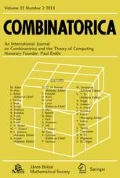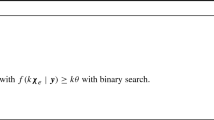Abstract
Submodular function minimization (SFM) is a fundamental and efficiently solvable problem in combinatorial optimization with a multitude of applications in various fields. Surprisingly, there is only very little known about constraint types under which SFM remains efficiently solvable. The arguably most relevant non-trivial constraint class for which polynomial SFM algorithms are known are parity constraints, i.e., optimizing only over sets of odd (or even) cardinality. Parity constraints capture classical combinatorial optimization problems like the odd-cut problem, and they are a key tool in a recent technique to efficiently solve integer programs with a constraint matrix whose subdeterminants are bounded by two in absolute value.
We show that efficient SFM is possible even for a significantly larger class than parity constraints, by introducing a new approach that combines techniques from Combinatorial Optimization, Combinatorics, and Number Theory. In particular, we can show that effi- cient SFM is possible over all sets (of any given lattice) of cardinality r mod m, as long as m is a constant prime power. This covers generalizations of the odd-cut problem with open complexity status, and has interesting links to integer programming with bounded subdeterminants. To obtain our results, we establish a connection between the correctness of a natural algorithm, and the nonexistence of set systems with specific combinatorial properties. We introduce a general technique to disprove the existence of such set systems, which allows for obtaining extensions of our results beyond the above-mentioned setting. These extensions settle two open questions raised by Geelen and Kapadia [9] in the context of computing the girth and cogirth of certain types of binary matroids.
Similar content being viewed by others
References
S. Artmann, R. Weismantel and R. Zenklusen: A strongly polynomial algorithm for bimodular integer linear programming, in: Proceedings of the 49th Annual ACM Symposium on Theory of Computing (STOC), 1206–1219, 2017.
F. Barahona and M. Conforti: A construction for binary matroids, Discrete Mathematics66 (1987), 213–218.
D. A. Mix Barrington, R. Beigel and S. Rudich: Representing boolean functions as polynomials modulo composite numbers, Computational Complexity4 (1994), 367–382.
D. Chakrabarty, A. Sidford, Y. T. Lee, and Wong S. C: Subquadratic submodular function minimization, in: Proceedings of 49th Annual ACM Symposium on the Theory of Computing (STOC), 1220–1231, 2017.
M. Conforti and M. R. Rao: Some new matroids on graphs: Cut sets and the max cut problem, Mathematics of Operations Research12 (1987), 193–204.
W. H. Cunningham: On submodular function minimization, Combinatorica5 (1985), 185–192.
P. Frankl and R. M. Wilson: in:tersection theorems with geometric consequences, Combinatorica1 (1981), 357–368.
S. Fujishige: Submodular Functions and Optimization, Elsevier, 2005.
J. Geelen and R. Kapadia: Computing girth and cogirth in perturbed graphic matroids, Combinatorica38 (2017), 167–191.
M. X. Goemans and V. S. Ramakrishnan: Minimizing submodular functions over families of sets, Combinatorica15 (1995), 499–513.
S. Gopi: Private communication, 2017.
V. Grolmusz: Superpolynomial size set-systems with restricted intersections mod 6 and explicit ramsey graphs, Combinatorica20 (2000), 71–86.
M. Grötschel, L. Lovász and A. Schrijver: The ellipsoid method and its consequences in combinatorial optimization, Combinatorica1 (1981), 169–197.
M. Grötschel, L. Lovász and A. Schrijver: Corrigendum to our paper “The ellipsoid method and its consequences in combinatorial optimization”, Combinatorica4 (1984), 291–295.
M. Grötschel, L. Lovász and L. Schrijver: Geometric Algorithms and Combinatorial Optimization, volume 2 of Algorithms and Combinatorics, Springer, second corrected edition, 1993.
S. Iwata: Submodular function minimization, Mathematical Programming, Series B112 (2008), 45–64.
S. Iwata, L. Fleischer and S. Fujishige: A combinatorial strongly polynomial algorithm for minimizing submodular functions, Journal of the ACM48 (2001), 761–777.
S. Iwata and J. B. Orlin: A simple combinatorial algorithm for submodular function minimization, in: Proceedings of the 20th Annual ACM-SIAM Symposium on Discrete Algorithms (SODA), 1230–1237, 2009.
D. R. Karger: Global min-cuts in RNC, and other rami_cations of a simple minout algorithm, in: Proceedings of the 4th Annual ACM-SIAM Symposium on Discrete Algorithms (SODA), 21–30, 1993.
D. R. Karger and C. Stein: A new approach to the minimum cut problem, Journal of the ACM43 (1996), 601–640.
Y. T. Lee, A. Sidford and S. C. Wong: A faster cutting plane method and its implications for combinatorial and convex optimization, in: Proceedings of the 56th Annual IEEE Symposium on Foundations of Computer Science (FOCS), 1049–1065, 2015.
S. T. MCormick: Submodular function minimization, in: Discrete Optimization, volumes 12 of Handbooks in Operations Research and Management Science, 321–391. Elsevier, 2005, Updated version of 2013 available at: https://doi.org/pdfs.semanticscholar.org/903d/12346be328623e41e7bea2791a6e6df570fc.pdf.
M. W. Padberg and M. R. Rao: Odd minimum cut-sets and b-matchings, Mathematics of Operations Research7 (1982), 67–80.
A. Schrijver: A combinatorial algorithm minimizing submodular functions in strongly polynomial time, Journal of Combinatorial Theory, Series B80 (2000), 346–355.
A. Schrijver: Combinatorial Optimization, Polyhedra and Efficiency, Springer, 2003.
Z. Svitkina and L. Fleischer: Submodular approximation: Sampling-based algorithms and lower bounds, SIAM Journal on Computing40 (2011), 1715–1737.
Acknowledgments
We thank Karthekeyan Chandrasekaran for interesting discussions on related topics. Moreover, we are grateful to the anonymous referees for various comments and suggestions that helped to improve the quality of the presentation.
Author information
Authors and Affiliations
Corresponding authors
Additional information
A preliminary version of this paper appeared at the ACM-SIAM Symposium on Discrete Algorithms (SODA18).
Research supported in part by the Swiss National Science Foundation grant 200021_175573.
Research supported in part by the Swiss National Science Foundation grant 200021_165866.
Rights and permissions
About this article
Cite this article
Nägele, M., Sudakov, B. & Zenklusen, R. Submodular Minimization Under Congruency Constraints. Combinatorica 39, 1351–1386 (2019). https://doi.org/10.1007/s00493-019-3900-1
Received:
Revised:
Published:
Issue Date:
DOI: https://doi.org/10.1007/s00493-019-3900-1




